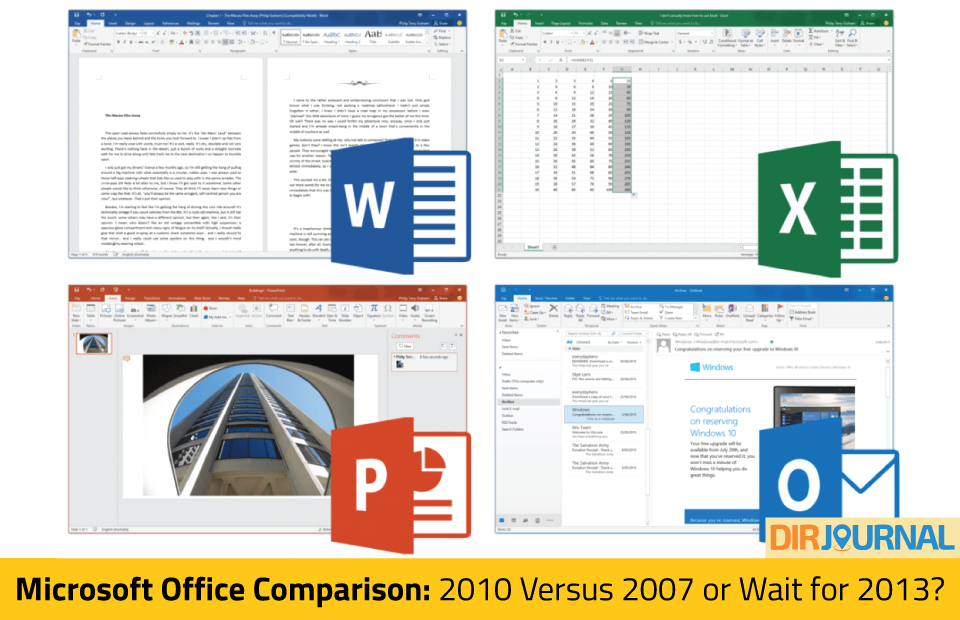
If you’re using an older version of Microsoft Office you’re probably wondering whether it is worthwhile to upgrade and just what the differences between the various versions are.
Microsoft’s intention to respond to all those that offer online productivity software free for personal use became a reality with their announcement that all their Office software is now available online – just like Google, Zobo, Adobe and others are doing.
Microsoft Office users can now either pay a yearly subscription or buy the software
or use a MS 2010 free but limited online version.
Some believe this move will benefit both corporate and smaller customers. While corporate customers will be able to get in on the paid subscriptions and tap into the online services, others can sign up for a service, where their online files will be stored and get help with data backup and security.
The best thing about this is that everyone will be allowed to use the online versions of different applications, such as Word and PowerPoint without it being necessary to buy the desktop versions. All they need to do is sign up for the free Windows Live account.
Office 2010 is still the current version (until 2013 is finally released).
Microsoft’s Office Pre-Launch Offer is good for anyone who buys the
current version of Office between October 19, 2012, and April 30, 2013.
That includes Windows users who purchase Office 2010 and
Mac users who pick up Office 2011 according to C/Net in
Office 2013 now free to new buyers of Office 2010 and 2011
Results of several technical reviews reveal that improvements have been made to the 2010 office suite, such as the Ribbon being the default interface OneNote, Outlook and all other Office applications. Not only is Ribbon made default but it has also been tweaked a bit.
Office 2010 is similar to 2007. 2013 is more cloud based and includes extended file format support, user interface updates, and support for touch. Office 2013 features.
2010 Improvements Over MS Office 2007
The new features added include:
- Better mail handling in Outlook including threaded email
- Improved video editing in PowerPoint
- Photo-editing tools
- Improved paste operation
- Enhanced productivity
- Ability to collaborate
MS 2010 IMPROVEMENTS TO OUTLOOK:
Let’s take a look at the most important Outlook. The new version adds a wide variety of new features that solve the major issue of e-mail overload. With the use of a full-blown Ribbon, most functions are within easy reach. Quick Steps is a new feature that is said to speed up mail handling.
As we all know, one of the main problems of Outlook has always been the confusion with following threads of messages. This version eradicates this problem and is sure to increase productivity. Now, a conversation can be “cleaned up” by deleting all the unwanted previous mail text and quoted text, which brings down the clutter by keeping only the unduplicated versions.
For all of you social networking fans, this version of Outlook may prove to be a disappointment as it does not have integration with Facebook and other social networking sites.
OFFICE 2010 PRODUCTIVITY ENHANCEMENTS
According to Microsoft, an estimated 400 million people have a Windows Live account with using services like Messenger and Hotmail, and 90 million corporate customers already have Office subscriptions.
There have been comments floating around that Microsoft is a bit too late to enter this arena and it may be difficult to catch up with the competition. In response, Microsoft says,
“Lots of competitors are doing nothing beyond copying what we have done in our product for years. They have weekly releases to add things like bold and italics and more than four fonts. We have to redefine what productivity means to 500 million people.”
Redefining productivity means offering tools that allow people to work simultaneously on presentations, documents and other things on the internet. Applications such as PowerPoint have also been pepped up, making it easier to add high-definition video into their projects.
CHANGES TO WORD IN MS 2010
There is not much of a change in Word; although, “search” now comes with some new features that allows users to search tables and charts as well as some other things too. Documents can be prettied up with the use of special effects to text, such as reflect, shadow and glow. Document sharing has been given new life and allows more than one person to work simultaneously on a document online.
Overall, you may find that this version of Word is
not much different from Word 2007.
CHANGES TO EXCEL 2010
Although, there are no major changes in Excel, there is the addition of “Sparklines,” which is the option to embed small charts into a worksheet next to data.
Another feature that could prove to be useful is the improvement in “Conditional formatting,” which allows the formatting to change based on the formula or value of the cell.
For corporate users, Microsoft is planning on shipping with the final version, “Project Gemini” add-on for Excel 2010, with the capacity to handle data in large amounts, and worksheets containing millions of rows.
MS 2010 CHANGES TO POWERPOINT
PowerPoint’s video features are one of the most used and this version sees many new features, such as a set of basic video editing tools that are now built into PowerPoint. They may not be as powerful as a high-end video editing software but they do their job efficiently.
There is also a great improvement in animations in PowerPoint, with a wide choice of animations that can be easily edited using the custom animation feature.
PUBLISHER AND ONENOTE
While the above are the most known features of Microsoft Office, there are other important ones too, such as Microsoft Publisher and OneNote, which have been improved in the 2010 over the 2007 version.
OFFICE 64 BIT VERSION
The new Office is available in 64-bit version too, but not for Windows XP or Windows Server 2003.
OFFICE 2010 MOBILE DEVICES
The most important change to Office 2010 is the Web-based access and access for mobile phones and other mobile clients introduced in the final version. There will also be mobile versions that allow viewing of documents on a smartphone or other mobile devices, as well as copy and paste between applications.
Outlook works even on mobile devices.
Although, it may not be completely different from the 2007 version, there are many solid improvements in Office 2010, which certainly makes it worth checking it out.
MS OFFICE 2013 AVAILABLE TO BUY?
So when can you get your hands on Office 2013 – and will the Operating System you have run it?
Office 2013 shipped to manufacturers in October 2012,
but the final edition will not be out until the middle of 2013.
10 awesome new additions in Office 2013 PCWorld (Oct 22, 2012)Office 2013 now free to new buyers of Office 2010 and 2011
C/Net (Oct 22, 2012)Microsoft also announced that Microsoft Office 2013 will only be compatible with
Windows 7 and Windows 8. XP and Vista users will be left out in the cold.
~ Softonic Review of MS Office 2013 ~
- Microsoft unveils Office 2013
- Guardian Office 2013 Review (Oct 30, 2012)
- ZDNet: Microsoft announces Office 2013 prices and packaging (Sep 2012)
- ZDNet: What you gain and lose with Office 2013 subscriptions (Sep 2012)
- Microsoft makes Office 2013 available to volume licensees (Oct 31,2012)
Download Office 2013 or
Download Office 2013 from official Microsoft Page







